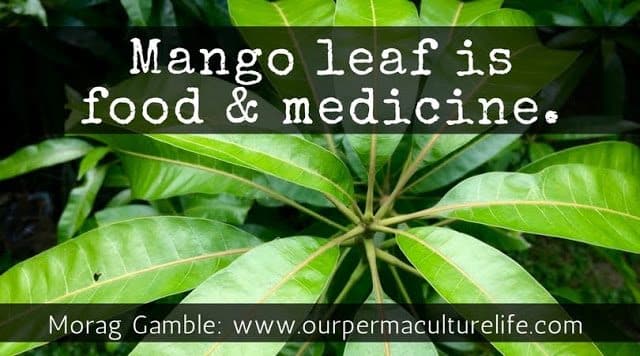Young mango leaves are a highly valued source of food and natural medicine in many parts of the world. Have you ever used them?
In one of my Daily Live at 5 sessions, I talked about how eat and use mango leaves. Check out the video below!
We are all familiar with the fruit of the deliciously juicy Mango (Mangifera indica) from the subtropical and tropical plant originally from India. It is the national fruit of India, Pakistan and the Philippines and the national tree of Bangladesh.
Almost half of the world’s production of mango is in India. There the mango leaves are considered auspicious and are commonly used to decorate front doors during festivals.
Everyone I know loves eating mango and looks forward to mango season. I grew up in a cooler climate so have always considered this an exquisite and exotic fruit to be savoured.
I was surprised when I first learned that in some parts of the world, people enjoy eating green mango and even more surprised when I heard about the many uses of mango leaves. I had been unwittingly walking past a huge source of food and medicine for years.
I started to question this potential when one of my mango trees, a dwarf mango, was damaged by frost leaving only the stock which doesn’t fruit. I had contemplated removing it, then decided to look further into the uses for the leaf. The young ones in particular look abundant, soft and healthy

Here are just some of the ways I found people use mango leaves.
Food
- In South East Asia, the young leaves of mango trees are cooked and eaten as a leafy green. They are rich in vitamins C, B and A and contain anti-oxidants.
Bathing
- Bathe in mango leaf water to relax and refresh, reduce anxiety and nervousness
Mouthwash
- Make a strong tea from the old leaves and rinse your mouth for good gum health and to ease mouth ulcers.
Burn relief
- Apply mango leaf ashes to burnt skin to soothe and relieve.
Medicine
Make a tea from the young leaves.
- Manage diabetes. Soak young leaves overnight in a cup of water and drink to relieve the symptoms of diabetes
- Help strengthen blood vessels and lower blood pressure
- Improve breathing. Mango leaf decoction helps people with bronchitis and asthma. Add some honey and use a cough mixture.
Note: Some people are sensitive to mango skins, leaves, bark. If you are one of these people, sorry this post is not for you!
What is permaculture?
To learn more about permaculture check out my 4 part permaculture series and take a look at Our Permaculture Life youtube channel where I have uploaded over 100 films I have made in my permaculture garden and in conversation with others. Dive deeper into this blog too and you will find over 400 permaculture articles.
Now is such a great time to learn more about permaculture and consider making permaculture your way of life and livelihood too. To help with this, I offer two online permaculture courses:
- Permaculture Educators Program – Permaculture Design & Teaching Certificates
- The Incredible Edible Garden – permaculture gardening course
I also encourage you to support free permaculture education programs for women and youth in the global south through our registered permaculture charity, the Ethos Foundation.


